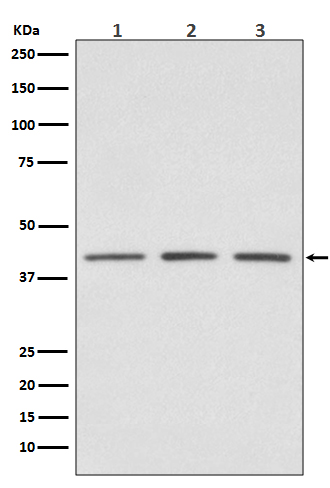PRMT1 Antibody
Rabbit mAb
- SPECIFICATION
- CITATIONS
- PROTOCOLS
- BACKGROUND

Application
| WB, IHC, ICC, CHIP |
|---|---|
| Primary Accession | Q99873 |
| Reactivity | Rat |
| Clonality | Monoclonal |
| Other Names | Histone-arginine N-methyltransferase PRMT1; ANM1; HCP1; IR1B4; HRMT1L2; |
| Isotype | Rabbit IgG |
| Host | Rabbit |
| Calculated MW | 42462 Da |
| Dilution | WB 1:500~1:1000 IHC 1:50~1:200 ICC/IF 1:100~1:500 |
|---|---|
| Purification | Affinity-chromatography |
| Immunogen | A synthesized peptide derived from human PRMT1 |
| Description | Arginine methyltransferase that methylates (mono and asymmetric dimethylation) the guanidino nitrogens of arginyl residues present in proteins such as ESR1, histone H2, H3 and H4, PIAS1, HNRNPA1, HNRNPD, NFATC2IP, SUPT5H, TAF15 and EWS. Constitutes the main enzyme that mediates monomethylation and asymmetric dimethylation of histone H4 'Arg-4' (H4R3me1 and H4R3me2a, respectively), a specific tag for epigenetic transcriptional activation. |
| Storage Condition and Buffer | Rabbit IgG in phosphate buffered saline , pH 7.4, 150mM NaCl, 0.02% sodium azide and 50% glycerol. Store at +4°C short term. Store at -20°C long term. Avoid freeze / thaw cycle. |
| Name | PRMT1 (HGNC:5187) |
|---|---|
| Function | Arginine methyltransferase that methylates (mono and asymmetric dimethylation) the guanidino nitrogens of arginyl residues present in proteins such as ESR1, histone H2, H3 and H4, FMR1, ILF3, HNRNPA1, HNRNPD, NFATC2IP, SUPT5H, TAF15, EWS, HABP4, SERBP1, RBM15, FOXO1, CHTOP, MAP3K5/ASK1, MICU1 and NPRL2 (PubMed:10749851, PubMed:15741314, PubMed:16879614, PubMed:18951090, PubMed:22095282, PubMed:25284789, PubMed:26575292, PubMed:26876602, PubMed:27642082, PubMed:30765518, PubMed:31257072, PubMed:38006878). Constitutes the main enzyme that mediates monomethylation and asymmetric dimethylation of histone H4 'Arg-3' (H4R3me1 and H4R3me2a, respectively), a specific tag for epigenetic transcriptional activation. May be involved in the regulation of TAF15 transcriptional activity, act as an activator of estrogen receptor (ER)-mediated transactivation, play a key role in neurite outgrowth and act as a negative regulator of megakaryocytic differentiation, by modulating p38 MAPK pathway. Methylates RBM15, promoting ubiquitination and degradation of RBM15 (PubMed:26575292). Methylates MRE11 and TP53BP1, promoting the DNA damage response (PubMed:15741314, PubMed:16294045, PubMed:29651020). Methylates FOXO1 and retains it in the nucleus increasing its transcriptional activity (PubMed:18951090). Methylates CHTOP and this methylation is critical for its 5-hydroxymethylcytosine (5hmC)-binding activity (PubMed:25284789). Methylates MAP3K5/ASK1 at 'Arg-78' and 'Arg-80' which promotes association of MAP3K5 with thioredoxin and negatively regulates MAP3K5 association with TRAF2, inhibiting MAP3K5 stimulation and MAP3K5-induced activation of JNK (PubMed:22095282). Methylates H4R3 in genes involved in glioblastomagenesis in a CHTOP- and/or TET1- dependent manner (PubMed:25284789). Plays a role in regulating alternative splicing in the heart (By similarity). Methylates NPRL2 at 'Arg-78' leading to inhibition of its GTPase activator activity and then the GATOR1 complex and consequently inducing timely mTORC1 activation under methionine-sufficient conditions (PubMed:38006878). |
| Cellular Location | Nucleus. Nucleus, nucleoplasm {ECO:0000250|UniProtKB:Q9JIF0}. Cytoplasm. Cytoplasm, cytosol {ECO:0000250|UniProtKB:Q9JIF0}. Lysosome membrane. Note=Mostly found in the cytoplasm Colocalizes with CHTOP within the nucleus. Low levels detected also in the chromatin fraction (By similarity). Upon methionine stimulation, localizes to the lysosome membrane in an NPRL2-dependent manner (PubMed:38006878). {ECO:0000250|UniProtKB:Q9JIF0, ECO:0000269|PubMed:38006878} |
| Tissue Location | Widely expressed (PubMed:11097842). Expressed strongly in colorectal cancer cells (at protein level) (PubMed:28040436). Expressed strongly in colorectal cancer tissues compared to wild-type colon samples (at protein level) (PubMed:28040436). Expressed strongly in colorectal cancer tissues compared to wild-type colon samples (PubMed:28040436) |

Thousands of laboratories across the world have published research that depended on the performance of antibodies from Abcepta to advance their research. Check out links to articles that cite our products in major peer-reviewed journals, organized by research category.
info@abcepta.com, and receive a free "I Love Antibodies" mug.
Provided below are standard protocols that you may find useful for product applications.
If you have used an Abcepta product and would like to share how it has performed, please click on the "Submit Review" button and provide the requested information. Our staff will examine and post your review and contact you if needed.
If you have any additional inquiries please email technical services at tech@abcepta.com.













 Foundational characteristics of cancer include proliferation, angiogenesis, migration, evasion of apoptosis, and cellular immortality. Find key markers for these cellular processes and antibodies to detect them.
Foundational characteristics of cancer include proliferation, angiogenesis, migration, evasion of apoptosis, and cellular immortality. Find key markers for these cellular processes and antibodies to detect them. The SUMOplot™ Analysis Program predicts and scores sumoylation sites in your protein. SUMOylation is a post-translational modification involved in various cellular processes, such as nuclear-cytosolic transport, transcriptional regulation, apoptosis, protein stability, response to stress, and progression through the cell cycle.
The SUMOplot™ Analysis Program predicts and scores sumoylation sites in your protein. SUMOylation is a post-translational modification involved in various cellular processes, such as nuclear-cytosolic transport, transcriptional regulation, apoptosis, protein stability, response to stress, and progression through the cell cycle. The Autophagy Receptor Motif Plotter predicts and scores autophagy receptor binding sites in your protein. Identifying proteins connected to this pathway is critical to understanding the role of autophagy in physiological as well as pathological processes such as development, differentiation, neurodegenerative diseases, stress, infection, and cancer.
The Autophagy Receptor Motif Plotter predicts and scores autophagy receptor binding sites in your protein. Identifying proteins connected to this pathway is critical to understanding the role of autophagy in physiological as well as pathological processes such as development, differentiation, neurodegenerative diseases, stress, infection, and cancer.


